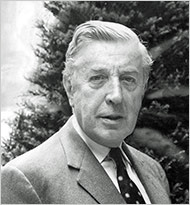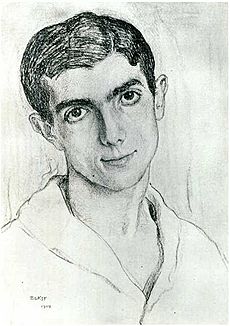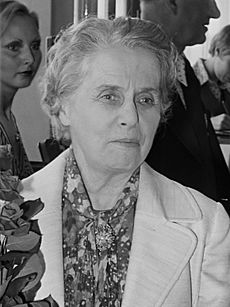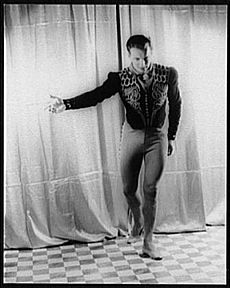Frederick Ashton facts for kids
Quick facts for kids
Frederick Ashton
|
|
|---|---|
 |
|
| Born |
Frederick William Mallandaine Ashton
17 September 1904 Guayaquil, Ecuador
|
| Died | 18 August 1988 (aged 83) Chandos Lodge, Eye, Suffolk, England
|
| Nationality | British |
| Occupation | Choreographer |
| Years active | 1926–1980 |
|
Notable work
|
|
Sir Frederick William Mallandaine Ashton (born September 17, 1904 – died August 18, 1988) was a very famous British ballet dancer and choreographer. A choreographer is someone who creates dance routines for ballets. He also directed and choreographed for opera, films, and stage shows.
Frederick Ashton really wanted to be a dancer, even though his family didn't approve. He started learning ballet at an older age than most dancers. He was taught by famous teachers like Léonide Massine and Marie Rambert. In 1926, Marie Rambert encouraged him to try making up dances, and that's when he found his true calling.
Ashton became the main choreographer for Ninette de Valois's ballet company in 1935. This company later became known as the Royal Ballet. He worked there until 1963, when he took over from de Valois as the director. He led the Royal Ballet until he retired in 1970.
Frederick Ashton is known for creating a special style of English ballet. Some of his most famous works include Façade (1931), Symphonic Variations (1946), Cinderella (1948), and La fille mal gardée (1960). He also created the ballet film The Tales of Beatrix Potter (1970).
Contents
Frederick Ashton's Life and Career
Early Life and Dream to Dance
Frederick Ashton was born in Guayaquil, Ecuador, on September 17, 1904. He was the fourth of five children. His father worked for a cable company and was also a vice-consul at the British consulate.
In 1907, his family moved to Lima, Peru, where he went to a Dominican school. When they returned to Guayaquil in 1914, he attended a school for English children. A big moment for him was seeing the famous dancer Anna Pavlova perform in 1917. After that, he knew he wanted to be a dancer.
Dancing was not a common career choice for young men from traditional English families back then. Ashton's father was very against it. His mother would say he wanted to "go on the stage," but she couldn't bring herself to say "into the ballet." In 1919, his father sent him to Dover College in England, where he was unhappy. He didn't fit in at the school.
He wasn't very interested in schoolwork. After leaving school in 1921, his father wanted him to work in business. He got a job at a company in the City of London that imported and exported goods. His ability to speak Spanish and French, as well as English, was helpful. In 1924, his father passed away.
Learning to Dance and Choreograph

Even though his family didn't approve, Ashton secretly followed his dream to dance. At the age of twenty, which was quite late for a dancer, he was accepted as a student by Léonide Massine. After Massine left London, Ashton became a student of Marie Rambert. She saw his talent and encouraged him to try creating dances.
His first attempt at choreography was in 1926 for a show. The show featured a small ballet called A Tragedy of Fashion: or The Scarlet Scissors. Critics liked it, calling it a "chic trifle." The costumes and sets were designed by Sophie Fedorovitch, who became his close friend and artistic helper for over twenty years.
Marie Rambert wanted her students to see more of the dance world. She took them to watch performances by the Diaghilev Ballet, which greatly influenced Ashton. In 1930, Ashton created an interesting ballet called Capriol Suite. He studied old 16th-century French dances to create a piece that mixed strong male leaps with elegant duets. The next year, Rambert started the Ballet Club, which later became the Ballet Rambert. Ashton was the main choreographer and a lead dancer.
In the early 1930s, Ashton created many ballets, including Façade (1931) and Les Masques (1933). He also choreographed for other shows, like musicals and operas in London's West End.
Working with the Vic-Wells Ballet
Ashton started working with Ninette de Valois, who founded the Vic-Wells Ballet, in 1931. He created a funny ballet called Regatta for her company. While reviews were mixed, Ashton was now seen as a very talented choreographer. He was becoming well-known in Britain.

In 1933, Ashton created another work for de Valois's company, Les Rendezvous. This ballet was a big success right away and is still performed today by the Royal Ballet. In 1935, de Valois made Ashton the main choreographer for her company. He worked with the musical director Constant Lambert and dancers like Alicia Markova and Robert Helpmann.
Ashton's early years with the Vic-Wells Ballet were very productive. He created works like Apparitions (1936) and Nocturne (1936). His witty ballets A Wedding Bouquet and Les Patineurs from 1937 are still performed.
By the late 1930s, Ashton's work was becoming known internationally. In 1934, he choreographed an opera in New York. In 1939, he created his first ballet for a foreign company, the Ballet Russe de Monte Carlo. He also continued to choreograph for films and operas.
Leading the Sadler's Wells Ballet
Just before World War II began, Ashton decided to stay with de Valois's company, which was soon renamed "Sadler's Wells Ballet." During the war, he created some more serious works, like Dante Sonata. This ballet showed the struggle between good and evil.
In 1941, Ashton joined the Royal Air Force for war service. He worked as an officer, analyzing aerial photographs and later as an intelligence officer. He was sometimes allowed time off to continue his ballet work. He collaborated with composer William Walton on The Quest (1943), but it was not a big success.
After the war, de Valois moved her company from Sadler's Wells to the Royal Opera House in Covent Garden. Ashton's first ballet for the company in its new home was Symphonic Variations (1946). This ballet is considered a masterpiece and helped define the English style of dancing. It was an immediate success and is still performed today.
Another ballet without a story was Scènes de ballet (1947). In 1948, Ashton created his first major three-act ballet for a British company, his version of Prokofiev's Cinderella. Ashton himself, along with Robert Helpmann, famously played Cinderella's funny stepsisters. Their comedy was a big hit with audiences.
In the late 1940s and early 1950s, Ashton also worked for other ballet companies. He created ballets for the Ballets de Paris and the New York City Ballet. He also choreographed for films like The Tales of Hoffmann (1951) and directed operas.
Ashton's second full-length ballet for de Valois's company was Sylvia (1952). His third full-length ballet was Romeo and Juliet for the Royal Danish Ballet in 1955. It was very successful, but Ashton felt the Covent Garden theatre was too big for his version of the story.
Becoming Director of the Royal Ballet
In 1956, Queen Elizabeth II gave the Sadler's Wells Ballet a special title: "the Royal Ballet." This showed how important the company had become. It was seen as one of the best ballet companies outside of Russia. De Valois remained the director, and Ashton was the main choreographer.

One of Ashton's most famous ballets, La fille mal gardée, was created for the Royal Ballet in 1960. He did a lot of research for this ballet, using music from 1828. The ballet mixed classical ballet with English folk dances. It was an instant success and is still performed by many companies around the world.
When Ninette de Valois retired in 1963, Ashton became the director of the Royal Ballet. Many people remember his time as director as a "golden age" for the company. The corps de ballet (the group of dancers who perform together) was considered one of the best in the world. He continued to create new ballets and also brought in works by other famous choreographers like Bronislava Nijinska and Antony Tudor.
Ashton's ballets during his time as director included The Dream (1964) and Enigma Variations (My Friends Pictured Within) (1968). He retired in July 1970 after a special farewell show.
After retiring, Ashton created several shorter ballets. His longer works included the film The Tales of Beatrix Potter (1970) and A Month in the Country (1976). This ballet was based on a play by Ivan Turgenev. It is still performed regularly.
Frederick Ashton passed away peacefully in his sleep on August 19, 1988, at his home in Suffolk, England.
Ashton's Amazing Ballets
Ashton created more than eighty ballets. Here are some of his most well-known works:
- Full-length ballets
- Cinderella (1948)
- Sylvia (1952)
- Romeo and Juliet (1955) – created for the Royal Danish Ballet.
- Ondine (1958)
- La fille mal gardée (1960)
- Shorter works
- Façade (1931)
- Apparitions (1936)
- Les Patineurs (1937)
- A Wedding Bouquet (1937)
- Horoscope (1938)
- Symphonic Variations (1946)
- Scènes de ballet (1948)
- Illuminations (1950)
- Daphnis and Chloe (1951)
- Birthday Offering (1956)
- The Two Pigeons (1961)
- Marguerite and Armand (1963)
- The Dream (1964)
- Sinfonietta (1967)
- Jazz Calendar (1968)
- Enigma Variations (1968)
- The Walk to the Paradise Garden (1972)
- A Month in the Country (1976)
- Rhapsody (1980)
- Varii Capricci (1983)
The "Fred Step"
Ashton often included a special dance step in many of his ballets. Dancers called it "the Fred step." It was based on a step used by the famous dancer Anna Pavlova.
The step involves a series of small, quick movements. It was first used in a short ballet in 1930. After 1931, it became a regular part of his choreography. Ashton himself danced this step when he played the timid sister in Cinderella. He also danced a gentle version of it with Margot Fonteyn in a ballet created for her 60th birthday. The Royal Ballet has a video on its website showing how to do the "Fred step."
His Lasting Legacy
Ashton left the rights to many of his ballets to his friends and colleagues. This helped ensure that his amazing works would continue to be performed. For example, he left Daphnis and Chloe and Ondine to Margot Fonteyn.
To keep Ashton's legacy alive, the Frederick Ashton Foundation was started in 2011. This foundation works closely with the Royal Ballet to preserve and promote his ballets.
Awards and Recognition
Frederick Ashton received many honors during his life. From Britain, he was made a Commander of the British Empire (CBE) in 1950. He was knighted in 1962, which means he became "Sir" Frederick Ashton. He also received the Companion of Honour in 1970 and the very special Order of Merit in 1977.
He also received honors from other countries, like the Legion of Honour from France in 1960. He was given honorary degrees from several universities, including Durham, Oxford, and London.
Images for kids
See also
 In Spanish: Frederick Ashton para niños
In Spanish: Frederick Ashton para niños


